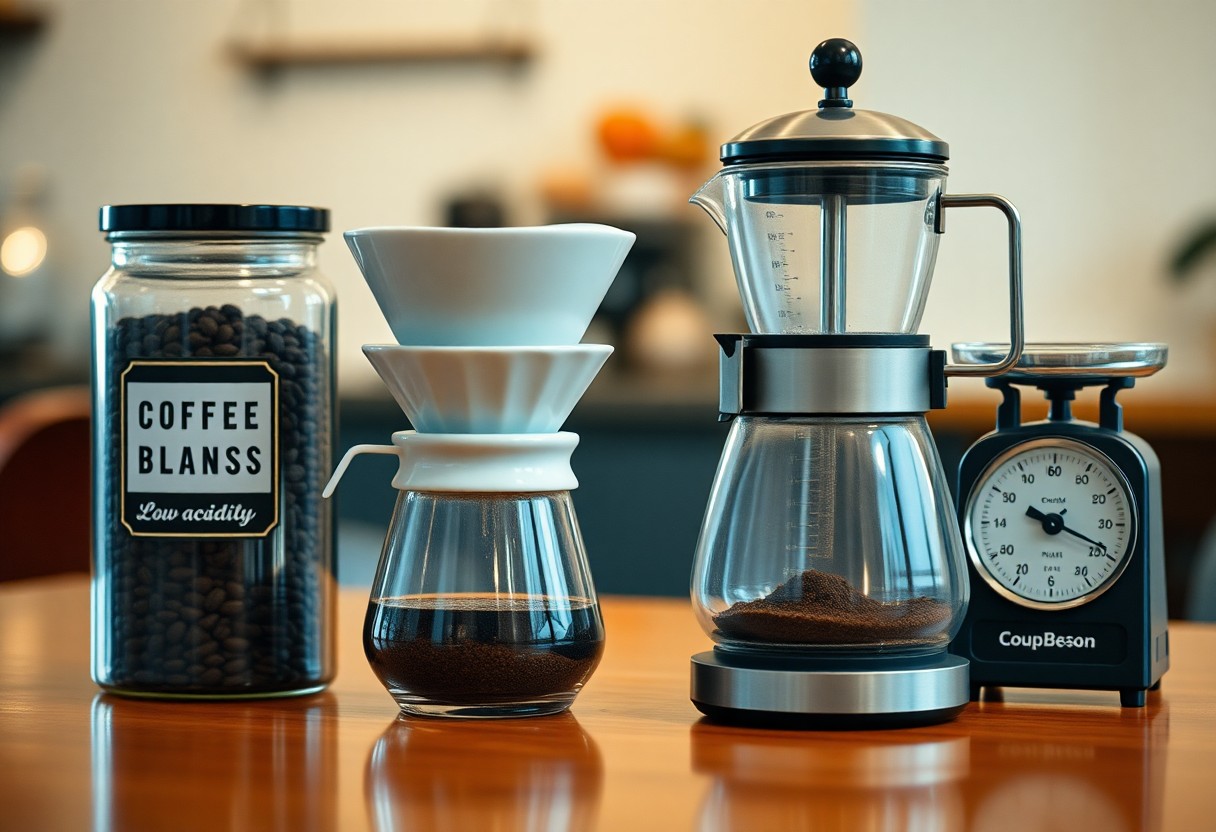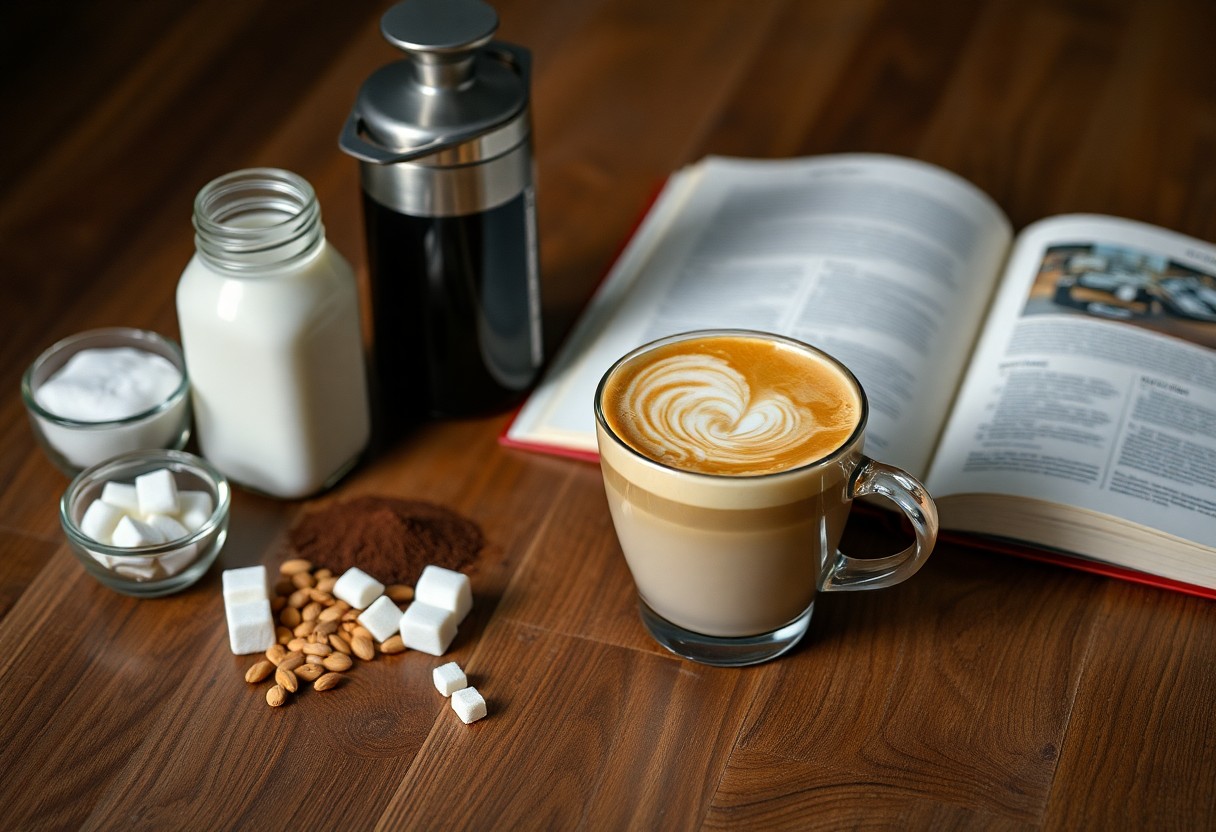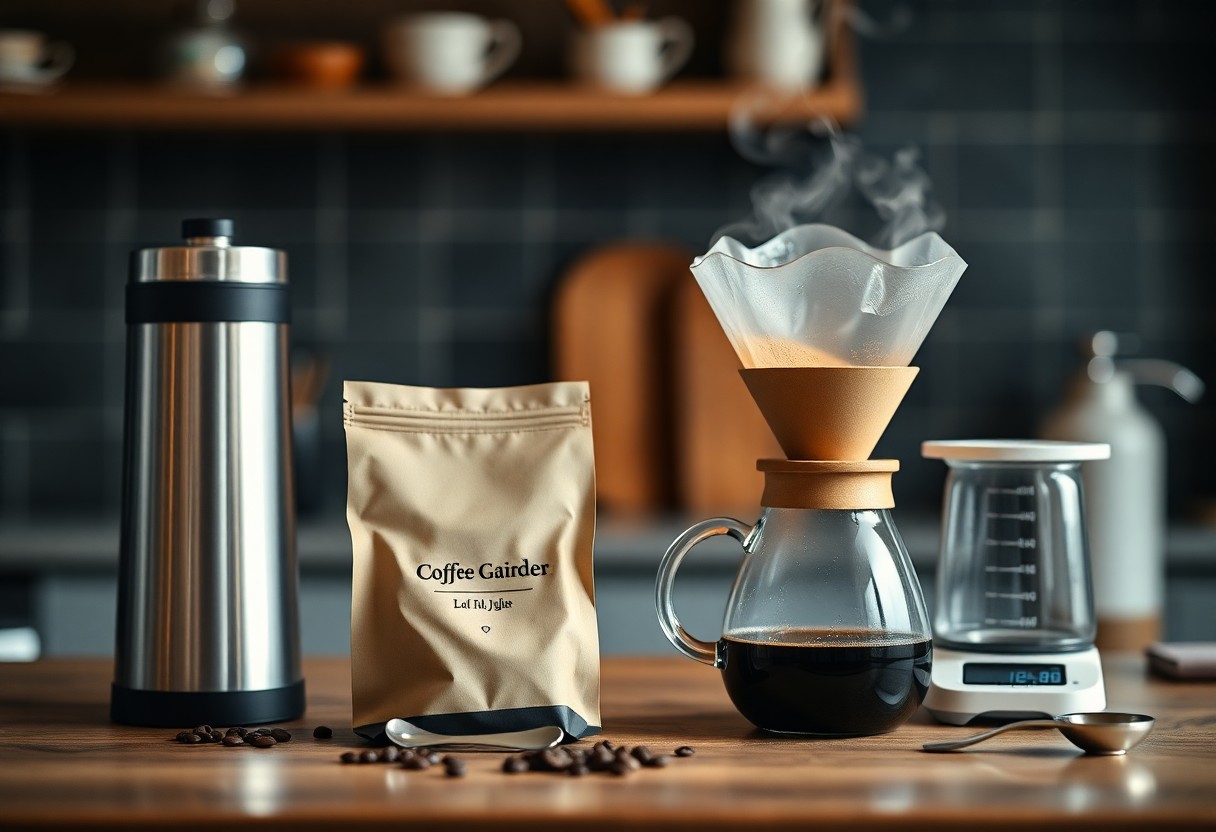There’s a world of low-acidity coffee options available for you if you suffer from a sensitive stomach. This guide will help you navigate the brewing process to ensure that your coffee is not only gentle on your digestive system but also rich in flavor. By choosing the right beans and brewing methods, you can enjoy your favorite morning pick-me-up without the discomfort that often accompanies traditional brews. Get ready to savor a delicious cup of coffee that harmonizes with your body!

Key Takeaways:
- Opt for beans labeled as low-acidity or specialty coffee, as they are gentler on the stomach and less likely to cause discomfort.
- Brewing methods such as cold brew or French press can help extract a smoother flavor profile while reducing acidity levels.
- Experiment with different grind sizes and brewing times to find the optimal balance that enhances flavor without aggravating sensitivity.
The Science of Low-Acidity Beans
Understanding the science behind low-acidity beans offers valuable insights into your coffee choices. Naturally, coffee acidity primarily originates from the specific growing conditions, processing methods, and bean varieties. Characteristics such as the elevation where the coffee is grown and the soil’s mineral composition play a significant role in determining acidity levels. The right combination creates coffees that are easier on your stomach, allowing you to enjoy a cup without discomfort.
Bean Varieties: Where Low Acidity Begins
Low-acidity coffee beans primarily come from specific regions and varietals known for their smoother profiles. Look for beans labeled as Arabica, especially those sourced from Brazil and Colombia. These regions produce coffee with naturally lower acidity due to their growing conditions. Additionally, varietals such as Sumatra Mandheling and Hawaiian Kona exhibit these qualities, making them excellent choices for sensitive stomachs.
The Role of Roast Levels in Acidity
Roast levels significantly influence the acidity of coffee. Dark roasts, for example, tend to have lower acidity than light roasts because the roasting process breaks down some of the acidic compounds. When beans are roasted for longer durations, their natural acids are diminished, leading to a smoother and more mellow flavor profile. This translates to a coffee that is gentler on your stomach and less likely to cause any discomfort, especially if you prefer a full-bodied taste.
As coffee beans undergo roasting, the Maillard reaction occurs, enhancing sugar caramelization while reducing acidity concurrently. Darker roasts like French or Italian roast often display rich, bold flavors with notes of chocolate and smoke, minimizing perceived acidity. On the other hand, lighter roasts maintain more of the beans’ natural acidity, often resulting in brighter, more complex flavors. For your sensitive stomach, aiming for a medium to dark roast can provide the balance of flavor and comfort while savoring your coffee experience.
Brewing Techniques for Gentle Sips
Choosing the right brewing technique can significantly impact your low-acidity coffee experience. To ensure a milder, smoother cup that is gentle on your stomach, opt for methods that enhance flavor while minimizing acidity. Brewing processes like cold brewing or using a French press allow for a more delicate balance, extracting sugars and oils without over-extracting bitter compounds that contribute to acidity. Consider these techniques your allies in crafting the perfect low-acid brew.
Optimal Brewing Methods for Low Acidity
The most effective brewing methods for low-acid coffee include cold brew, French press, and pour-over. Cold brew involves steeping coarsely ground coffee in cold water for an extended time, typically 12-24 hours, producing a naturally sweeter and smooth profile. The French press, with its gentle extraction, allows for rich flavors while retaining lower acidity levels. Pour-over can be adjusted for grind size and water temperature, making it versatile for achieving a balanced cup. Utilizing these methods ensures you enjoy a delightful coffee experience without the downside of acidity.
Adjusting Brew Times and Temperatures for Comfort
Modifying brew times and temperatures is key to achieving a less acidic cup. Ideally, brewing at temperatures around 195°F to 205°F helps extract flavors without releasing excessive oils and acids. Limiting brew times to under 4 minutes for methods like French press or pour-over can also prevent bitterness. If using cold brew, a longer infusion allows for a sweeter, gentler taste profile. Experimenting with these elements lets you tailor each cup to your comfort needs.
| Method | Adjustment |
| Cold Brew | Steep for 12-24 hours |
| French Press | Limit brew time to 3-4 minutes |
| Pour-Over | Brew at 195°F to 205°F |
Tweaking your brewing parameters is an effective way to enhance your coffee experience. Lower temperatures during extraction help prevent the release of bitter compounds, minimizing acidity and allowing the natural sweetness of the coffee to shine through. For cold brews, maintaining a longer steep time at room temperature or in the fridge can yield a smooth, mellow flavor profile. These adjustments empower you to create a coffee that caters to your digestive comfort.
| Temperature | Impact |
| Below 195°F | Under-extraction, resulting in weak flavors |
| Above 205°F | Over-extraction, leading to bitterness and acidity |
Flavor Profiles: Enjoying Coffee Without the Bite
Low-acidity coffees offer a delightful spectrum of flavors that can be enjoyed without the uncomfortable acidity associated with traditional brews. Notes of chocolate, nuts, and caramel often dominate these profiles, creating a smooth, well-rounded taste experience. You may discover these gentle flavors can be accentuated through specific brewing methods or by selecting high-quality beans carefully sourced from regions known for their low acidity. This means you can savor your coffee without the usual bite, allowing you to fully enjoy your daily cup.
Identifying and Enhancing Low-Acidity Flavors
Recognizing the low-acidity flavor profiles in your coffee involves tasting for rich notes such as dark chocolate, toffee, or spice. Seeking out beans from Brazil, Guatemala, or Sumatra can provide you with these pleasant tastes. To enhance them, consider using a French press or cold brew method, which naturally extracts the coffee’s mellow characteristics, minimizing any potential sharpness. Experimenting with different roast levels will also help you discover the flavors that resonate most with your palate.
Coffee Pairings That Alleviate Stomach Sensitivity
Complementing your low-acidity coffee with the right pairings can enhance your overall enjoyment while reducing potential stomach discomfort. Opt for foods that are gentle on your digestive system, such as oatmeal, bananas, or yogurt. Spicy or highly acidic accompaniments should be avoided to ensure a pleasant experience. You might also consider munching on whole-grain toast or muffins to balance out the coffee’s flavors while keeping your stomach at ease.
Pairing low-acidity coffee with gentle foods not only enhances your coffee experience but also helps keep your stomach calm. For instance, the smooth, nutty notes of a Brazilian coffee complement the creamy texture of yogurt beautifully, which can further alleviate any potential acidity-related discomfort. Similarly, enjoying your brew alongside lightly buttered toast provides a satisfying, digestible companion that allows you to appreciate the flavors of your coffee without the risk of upset. Personal experimentation can lead you to the ideal combinations tailored to your taste and sensitivity.

The Impact of Additives: Creams, Sugars, and Alternatives
Additives like creams and sugars can significantly alter your coffee experience, particularly for sensitive stomachs. Many traditional creamers and sweeteners are highly acidic, which may exacerbate digestive discomfort. Opting for low-acid alternatives can enhance your cup while ensuring it remains gentle on your system. By choosing wisely, you can still enjoy a rich, flavorful coffee without triggering your sensitivity.
How Additives Affect Acidity Levels
The acidity of your coffee can increase with certain additives. For instance, regular milk and cream contain lactic acid, which might intensify stomach issues for sensitive individuals. Additionally, traditional sweeteners such as white sugar can also create a more acidic environment in your stomach. Identifying alternative options will help you maintain a low-acid profile.
Exploring Dairy Alternatives and Sweeteners
Dairy alternatives like almond, soy, and oat milk often present lower acidity options for your coffee. Furthermore, sweeteners such as stevia or monk fruit can add sweetness without contributing to acidity. These choices don’t just cater to digestive sensitivities, they can also enhance the overall flavor profile of your brew, offering a creamier or sweeter experience without the downside of traditional additives.
When navigating dairy alternatives and sweeteners, consider the flavor and texture they bring to your coffee. For example, almond milk offers a nutty flavor that can complement low-acid coffee nicely, while oat milk tends to be creamier, mimicking the mouthfeel of traditional dairy. Additionally, sweeteners like agave syrup may offer a more gentle sweetness with lower acidity, allowing you to indulge without compromise. Always experiment with different combinations until you find your perfect blend that caters to both taste and comfort.
Expert Tips from Coffee Connoisseurs
Coffee connoisseurs often emphasize the significance of selecting the right beans and methods for your brewing journey. To brew low-acidity coffee that is gentle on your stomach, explore these expert suggestions:
- Opt for specialty Arabica beans over Robusta for a smoother taste.
- Experiment with different brewing methods, like cold brew or pour-over, to reduce acidity.
- Maintain optimal water temperature, ideally between 195°F and 205°F.
- Invest in a burr grinder for a consistent grind size.
Thou shall enjoy coffee without the discomfort.
Insider Secrets for Achieving the Perfect Brew
To craft the perfect cup of low-acidity coffee, focus on the grind size and brew time. Using a coarser grind can minimize acidity in your beverage while a longer brewing time extracts deeper flavors without bitterness. Consider adjusting the water-to-coffee ratio to suit your palate, typically one to two grams of coffee for every milliliter of water.
Recommendations for Low-Acidity Coffee Brands
Several brands specifically cater to those seeking low-acidity beans. Consider trying the Ethiopian Yirgacheffe from Blue Bottle Coffee or the Swiss Water Decaf from Peet’s Coffee, both known for their mellow profiles. Additionally, Kingston offers a delightful low-acid blend called “Good Vibes,” prized for its smooth taste and gentle impact on the stomach.
Exploring these options, you’ll discover that the Ethiopian Yirgacheffe features floral notes balanced by a mild sweetness, while the Swiss Water Decaf is particularly appealing for those sensitive to caffeine. Kingston’s “Good Vibes” highlights chocolate and caramel flavors, providing a warm comfort in every sip. Finding the right low-acid coffee can elevate your daily ritual without compromising your digestive well-being.
To wrap up
So, if you’re sensitive to acidity but still crave a flavorful cup of coffee, exploring low-acidity options can greatly enhance your experience. By selecting the right beans, adjusting your brewing method, and considering factors like grind size and water temperature, you can enjoy your daily brew without discomfort. Incorporate these tips into your routine, and you’ll be well on your way to savoring a satisfying cup that suits your stomach. Your coffee experience doesn’t have to compromise your comfort—let low-acidity coffee open up new possibilities for enjoyment.
FAQ
Q: What is low-acidity coffee and why is it better for sensitive stomachs?
A: Low-acidity coffee is specifically processed to contain lower levels of natural acids found in coffee beans. It is often gentler on the stomach and may cause less discomfort for individuals who experience sensitivity. This type of coffee retains its rich flavor profile while minimizing the risk of acid reflux, heartburn, or stomach upset.
Q: How can I identify low-acidity coffee when shopping?
A: Look for coffee that is labeled as low-acidity or smooth. Beans from certain regions, like Brazil or Sumatra, are naturally lower in acidity. Additionally, opt for medium to dark roasts, as the roasting process tends to reduce acidity levels. Reading reviews and tasting samples can also help you find suitable options.
Q: What brewing methods are best for making low-acidity coffee?
A: Brewing methods that involve cooler temperatures, such as cold brew and French press, are excellent for low-acidity coffee. Cold brew, in particular, extracts fewer acids from the coffee beans, resulting in a smooth and mild flavor. Additionally, using a drip brewer or pour-over method can yield low-acidity results when done correctly.
Q: Can I reduce the acidity of regular coffee at home?
A: Yes, there are several techniques you can try to lower acidity in regular coffee. Adding a pinch of baking soda to your ground coffee before brewing can neutralize some of the acids. Additionally, using a coarser grind and brewing with cooler water can also help diminish acidity levels without sacrificing flavor.
Q: How do I store low-acidity coffee to maintain its freshness?
A: To keep low-acidity coffee fresh, store it in an airtight container in a cool, dark place, such as a pantry. Avoid exposing the coffee to light, moisture, or air, as these factors can lead to staleness. For the best flavor, consume the coffee within a few weeks of opening, and consider purchasing whole beans and grinding them just before use to preserve quality.
